
Corals are colonial marine invertebrates within the class Anthozoa of the phylum Cnidaria. They typically form compact colonies of many identical individual polyps. Coral species include the important reef builders that inhabit tropical oceans and secrete calcium carbonate to form a hard skeleton.

Coral bleaching is the process when corals become white due to loss of symbiotic algae and photosynthetic pigments. This loss of pigment can be caused by various stressors, such as changes in temperature, light, or nutrients. Bleaching occurs when coral polyps expel the zooxanthellae that live inside their tissue, causing the coral to turn white. The zooxanthellae are photosynthetic, and as the water temperature rises, they begin to produce reactive oxygen species. This is toxic to the coral, so the coral expels the zooxanthellae. Since the zooxanthellae produce the majority of coral colouration, the coral tissue becomes transparent, revealing the coral skeleton made of calcium carbonate. Most bleached corals appear bright white, but some are blue, yellow, or pink due to pigment proteins in the coral.
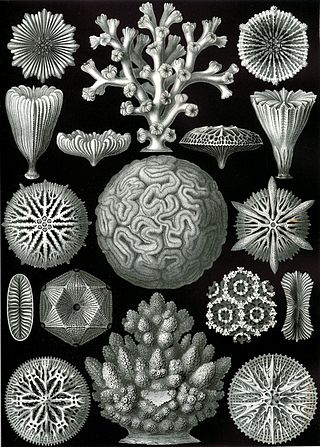
Scleractinia, also called stony corals or hard corals, are marine animals in the phylum Cnidaria that build themselves a hard skeleton. The individual animals are known as polyps and have a cylindrical body crowned by an oral disc in which a mouth is fringed with tentacles. Although some species are solitary, most are colonial. The founding polyp settles and starts to secrete calcium carbonate to protect its soft body. Solitary corals can be as much as 25 cm (10 in) across but in colonial species the polyps are usually only a few millimetres in diameter. These polyps reproduce asexually by budding, but remain attached to each other, forming a multi-polyp colony of clones with a common skeleton, which may be up to several metres in diameter or height according to species.
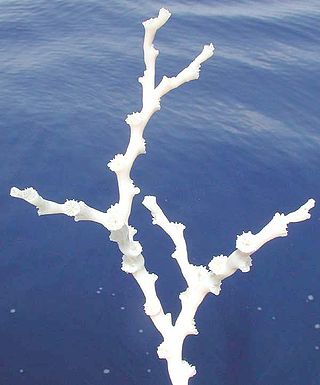
Lophelia pertusa, the only species in the genus Lophelia, is a cold-water coral that grows in the deep waters throughout the North Atlantic ocean, as well as parts of the Caribbean Sea and Alboran Sea. Although L. pertusa reefs are home to a diverse community, the species is extremely slow growing and may be harmed by destructive fishing practices, or oil exploration and extraction.
The Experimental Oculina Research Reserve preserves the Oculina Banks, a reef of ivory bush coral off the coast of Fort Pierce, Florida. Oculina varicosa is a U.S. National Marine Fisheries Service species of concern. Species of concern are those species about which the U.S. Government's National Oceanic and Atmospheric Administration (NOAA), National Marine Fisheries Service, has some concerns regarding status and threats, but for which insufficient information is available to indicate a need to list the species under the U.S. Endangered Species Act (ESA).

The Staghorn coral is a branching, stony coral, within the Order Scleractinia. It is characterized by thick, upright branches which can grow in excess of 2 meters in height and resemble the antlers of a stag, hence the name, Staghorn. It grows within various areas of a reef but is most commonly found within shallow fore and back reefs, as well as patch reefs, where water depths rarely exceed 20 meters. Staghorn corals can exhibit very fast growth, adding up to 5 cm in new skeleton for every 1 cm of existing skeleton each year, making them one of the fastest growing fringe coral species in the Western Atlantic. Due to this fast growth, Acropora cervicornis, serve as one of the most important reef building corals, functioning as marine nurseries for juvenile fish, buffer zones for erosion and storms, and center points of biodiversity in the Western Atlantic.
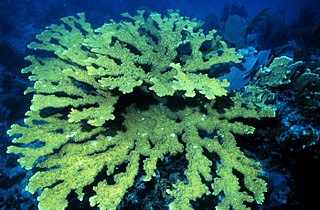
Elkhorn coral is an important reef-building coral in the Caribbean. The species has a complex structure with many branches which resemble that of elk antlers; hence, the common name. The branching structure creates habitat and shelter for many other reef species. Elkhorn coral is known to grow quickly with an average growth rate of 5 to 10 cm per year. They can reproduce both sexually and asexually, though asexual reproduction is much more common and occurs through a process called fragmentation.

The habitat of deep-water corals, also known as cold-water corals, extends to deeper, darker parts of the oceans than tropical corals, ranging from near the surface to the abyss, beyond 2,000 metres (6,600 ft) where water temperatures may be as cold as 4 °C (39 °F). Deep-water corals belong to the Phylum Cnidaria and are most often stony corals, but also include black and thorny corals and soft corals including the Gorgonians. Like tropical corals, they provide habitat to other species, but deep-water corals do not require zooxanthellae to survive.
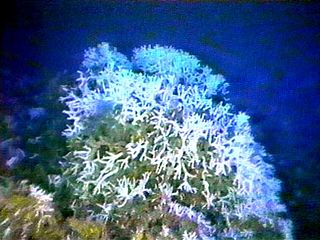
Oculina is a genus of colonial stony coral in the family Oculinidae. These corals are mostly found in the Caribbean Sea, the Gulf of Mexico and Bermuda but some species occur in the eastern Pacific Ocean. They occur at depths down to 1000 metres.

Oculina diffusa, commonly known as the diffuse ivory bush coral or ivory tree coral, is found in the eastern Atlantic Ocean, the Gulf of Mexico, and the Caribbean Sea. It is found in shallow water, usually down to 3 metres (9.8 ft) deep but occasionally as deep as 20 metres (66 ft). Its colonies are dense and have a yellow-brown color. It favours areas with high amounts of sedimentation.

Pavona duerdeni, the porkchop coral, is a coral that forms clusters of cream-colored lobes or discs. They grow in large colonies, divided into ridges or hillocks. The coral is considered to be uncommon due to its low confirmed abundance, yet they are more commonly found in Hawaii, the Indo-Pacific, and the Tropical Eastern Pacific. They make up some of the largest colonies of corals, and have a slow growth rate, as indicated by their dense skeletons. Their smooth appearance is due to their small corallites growing on their surface.
The resilience of coral reefs is the biological ability of coral reefs to recover from natural and anthropogenic disturbances such as storms and bleaching episodes. Resilience refers to the ability of biological or social systems to overcome pressures and stresses by maintaining key functions through resisting or adapting to change. Reef resistance measures how well coral reefs tolerate changes in ocean chemistry, sea level, and sea surface temperature. Reef resistance and resilience are important factors in coral reef recovery from the effects of ocean acidification. Natural reef resilience can be used as a recovery model for coral reefs and an opportunity for management in marine protected areas (MPAs).

Acropora pulchra is a species of colonial staghorn coral in the family Acroporidae. It is found on the back fringes of reefs in shallow water in the western Indo-Pacific Ocean. The oldest fossils of this species date back to the Pleistocene.

Orbicella faveolata, commonly known as mountainous star coral, is a colonial stony coral in the family Merulinidae. Orbicella faveolata is native to the coral coast of the Caribbean Sea and the Gulf of Mexico and is listed as "endangered" by the International Union for Conservation of Nature. O. faveolata was formerly known as Montastraea faveolata.
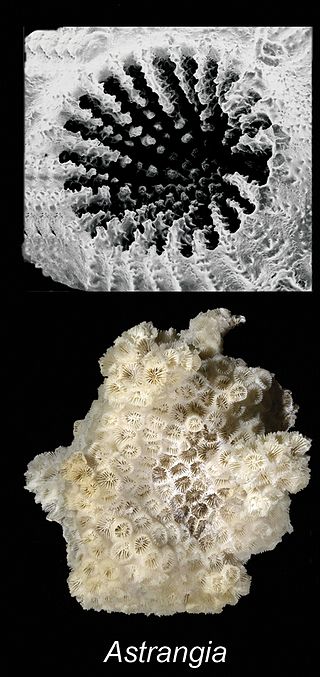
Astrangia poculata, the northern star coral or northern cup coral, is a species of non-reefbuilding stony coral in the family Rhizangiidae. It is native to shallow water in the western Atlantic Ocean and the Caribbean Sea. It is also found on the western coast of Africa. The International Union for Conservation of Nature lists this coral as being of "least concern". Astrangia poculata is an emerging model organism for corals because it harbors a facultative photosymbiosis, is a calcifying coral, and has a large geographic range. Research on this emerging model system is showcased annually by the Astrangia Research Working Group, collaboratively hosted by Roger Williams University, Boston University, and Southern Connecticut State University

Coelastrea aspera is a species of stony coral in the family Merulinidae. It is a colonial species native to the Indo-Pacific region where it occurs in shallow water. It was first described by the American zoologist Addison Emery Verrill in 1866 as Goniastrea aspera but it has since been determined that it should be in a different genus and its scientific name has been changed to Coelastrea aspera. This is a common species throughout much of its wide range and the International Union for Conservation of Nature has rated its conservation status as being of "least concern".

Porites cylindrica, commonly known as Hump coral, is a stony coral belonging to the subclass Hexacorallia in the class Anthozoa. Hexacorallia differ from other subclasses in that they have 6 or fewer axes of symmetry. Members of this class possess colonial polyps which can be reef-building, secreting a calcium carbonate skeleton. They are dominant in both inshore reefs and midshelf reefs.
The Virgin Islands Patch Reefs are numerous, small subtropical coral reef ecoregions. These reefs are located on all three islands; St. John, St. Thomas, and St. Croix. Of the three islands St. Croix, has an established barrier reef. It is approximately 20 meters deep and covers 485 sq km.

Oculina arbuscula is a branching temperate coral found along the east coast of the United States from Florida to North Carolina. It has a facultative symbiosis with microalgae of the family Symbiodiniaceae. Unlike tropical corals, O. arbuscula can survive without its algal endosymbionts by switching to a predominantly heterotrophic feeding strategy. Symbiotic colonies are typically found in shallower waters due to light availability, whereas aposymbiotic or mixed colonies are found as deep as 200m. The ability of O. arbuscula to exist in different symbiotic states makes it a good model system for studying the cnidarian-dinoflagellate symbiosis.

















